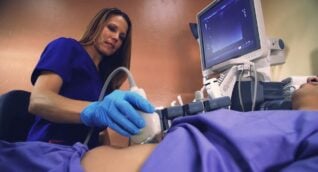Scrotal ultrasound is an imaging technique that uses sound waves to visualize a man’s testicles and the surrounding structures. Disorders in the scrotum can include testicular tumors, inflammation, infection, or tissue damage. Ultrasound is an excellent method for determining if a mass is solid or filled with fluid.
By using a special ultrasound transducer (probe), this test can visualize structures non-invasively and without exposing the patient to ionizing radiation (X-rays). This exam can help doctors decide if a mass in the scrotum is benign (non-cancerous) or malignant (cancerous). Scrotal ultrasound can also help evaluate cases of male infertility.
More basic information on ultrasound is available in the About Ultrasound section.
Each structure inside a man’s scrotum may be associated with different problems. Ultrasound of the scrotum can help your doctor make the correct diagnosis. Some disorders found within the scrotum include:
- Identifying tumors, inflammation, or torsion (painful twisting of the testicle).
- Diagnosing varicoceles, which are abnormal enlargements of veins that drain the testicle. This can be a cause of male infertility.
- Visualizing trauma to the scrotal structures.
- Finding undescended testes.
- Identifying problems of the epididymis (a tube that stores sperm), including inflammation (a condition called epididymitis), or abscess.
- Differentiating between potential cancers and benign cysts.
Benefits
- Scrotal ultrasound is an inexpensive, fast, and non-invasive way to assess problems with structures inside the scrotum.
- Ultrasound does not expose you to any ionizing radiation (X-rays).
- Unlike MRI, ultrasound can be used in patients with any type of metal in their body, including implantable medical devices.
- Ultrasound is very safe and has no side effects.
- There is no need to administer contrast for ultrasound exams.
- Ultrasound can detect soft tissue abnormalities that cannot be visualized with regular X-ray exams.
Risks
- The use of diagnostic ultrasound (without biopsy) has no known risks or harmful effects.
- Scrotal ultrasound is done in an ARA imaging center. The exam will take about 30 minutes and you will be in the imaging center for about an hour.
- You may be asked to change into a gown.
- You will be placed lying on your back on an exam table. You may have to change position during the exam.
- A water-based gel will be placed on your scrotum. The gel creates a sealed contact between your skin and the ultrasound probe. This eliminates any air pockets that may interfere with imaging. The probe will be moved around to capture images from different locations. The gel does not stain clothing.
- The technologist or radiologist performing the study may have to apply pressure with the probe to the body part being examined. If the area is tender, you may experience some discomfort.
- You can return to your normal activities after the exam is over.
Wear comfortable, loose-fitting clothing for the exam. Otherwise, no special preparation is required for scrotal ultrasound.
To schedule a scrotal ultrasound, please use our online scheduling tool in the Patient Portal or you may call our scheduling team at (512) 453-6100 or toll free at (800) 998-8214. A referral from your healthcare provider is required to make an appointment.
A radiologist, a physician specifically trained to interpret radiological examinations, will analyze the images and send a signed report to the provider who referred you to ARA. The physician will then share the results with you.
ARA wants to provide a safe, comfortable environment for patients and staff.
Patients may either bring or request a chaperone to accompany them during their exam to help protect and enhance their safety and comfort.
When requested, ARA will attempt to provide a chaperone with whom the patient feels comfortable. If a patient’s chaperone request cannot be accommodated, the patient will be given the opportunity to reschedule their exam.

